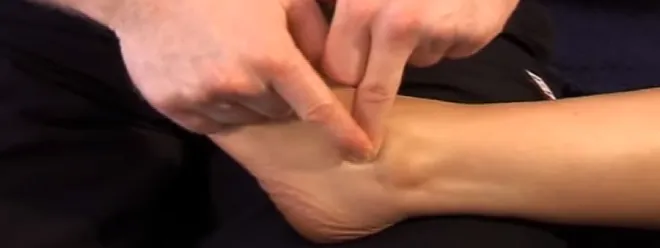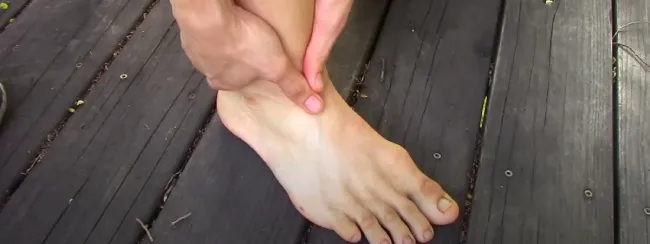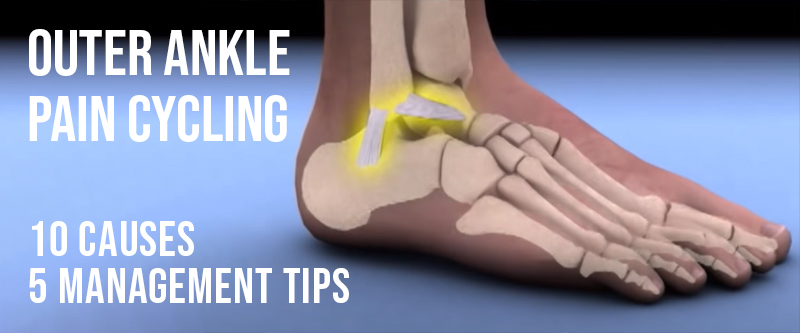Cycling is a repetitive motion that involves pushing down on the pedals with the feet. This ankle pain can limit your range of movement, make it challenging to maintain proper form while cycling, and dampen a cyclist’s motivation to ride.
It can also affect your balance and make transferring power from your legs to the pedals difficult, decreasing speed and performance.
Yes, cycling can cause outer ankle pain. Cleats too far forward, causing down pedaling, also causes the tendon to inflame and can cause pain on the outer ankle because of improper foot positioning, excessive “ankling” during pedaling, or if the cleat rotation doesn’t allow the foot to fall into its natural position.
In this blog post, we will explore the causes and treatment of outer ankle pain caused by cycling and how to manage and prevent it.
Outer Ankle Pain While Cycling: 5 Best Ways to Treat It

It may lead to various injuries, including external ankle pain. From incorrect bike fit and positioning to medical conditions like tendinitis, several factors can cause outer ankle pain in cyclists. Here are some causes of external ankle pain in cycling.
Incorrect Bike Fit and Positioning
One of the leading causes of outer ankle pain while cycling is a bike poorly fitted to the cyclist’s body. Most people assume any bike can work for them, which is a misconception. When the bike’s positioning is incorrect, it puts pressure on the outer ankle, leading to pain.
Overuse Injuries
Excessive cycling without adequate rest can cause bike-related injuries. Overuse injuries are prevalent among athletes and people who cycle long distances regularly. Overuse injuries occur when a body part is subjected to repetitive stress, leading to muscle fatigue and soreness.
Trauma
Any impact or force that affects the ankle joint can cause trauma. Trauma may occur while cycling because of falls, collisions with stationary objects, or other athletes. An outer ankle injury causes bruising, swelling, and pain.
Ankle Instability and Weakness
Ankle instability and weakness refer to a lack of strength or stability around the ankle joint. These conditions may occur because of previous injuries or weakness of the muscles supporting the ankle. Cyclists with ankle instability or weakness are at a higher risk of experiencing outer ankle pain.
Medical Conditions
Various medical conditions can cause pain in the external ankle while cycling. Arthritis, tendinitis, and plantar fasciitis are some of the common culprits. These conditions affect the ankle joints, muscles, and ligaments, resulting in outer ankle pain and discomfort.
Cycling Cleats
If your cycling cleats are not adjusted properly or do not fit correctly, it can cause discomfort and pain in your ankles. This is because the stress on your ankles increases because of the improper alignment of your feet and pedals. Therefore, it is important to ensure that your cycling cleats are well-fitted and adjusted to prevent any undue stress on your ankles.
Peroneal Tendonitis
Peroneal tendonitis is caused by the inflammation or irritation of the peroneal tendons. This typically occurs because of overuse, improper pedaling technique, or poor bike fit. Inflammation can cause pain in the ankle and foot, making cycling difficult.
Ankle Sprains
Ankle sprains are a common injury caused by sudden twists or effects. Symptoms may include pain, swelling, and limited mobility. It will be easier for the body to heal if you rest, apply ice, compress, and elevate the injured area.
Outer Ankle Injuries
Cyclists may get outer ankle pain from trauma, overuse, or biomechanical issues, such as supination or excessive pronation.
Foot and Ankle Cramps
Cramping in the feet and ankles during cycling is caused by dehydration, electrolyte imbalances, and fatigue. To prevent this, it is important to stay hydrated, consume enough electrolytes, and take enough rest. Stretching exercises before and after cycling can also help ease muscle fatigue.
5 Management Tips for Outer Ankle Pain During Cycling
Cycling, like any other form of exercise, may lead to injuries, such as outer ankle pain. When you experience this kind of pain while cycling, it is crucial to manage it promptly. To assist you in managing your extreme ankle pain, here are some tips:
Rest and Ice Therapy
Rest is essential for healing and minimizing the risk of re-injury. Suppose you experience outer ankle pain while cycling. Take a break from cycling and create a healing environment. If you apply ice therapy to your body, you can reduce inflammation and relieve pain. You should use an ice pack on your injured ankle for 15 to 20 minutes several times daily.
Compression and Elevation
Elevation and compression help reduce swelling and pain. Wear a compression bandage around your ankle to improve support, prevent swelling, and speed up healing. When resting, keep your ankle above your heart level for 30 minutes, four to five times daily.
Pain Medication and Anti-Inflammatory Drugs
The right pain reliever and anti-inflammatory can reduce pain and inflammation, allowing you to return to cycling. Consult your doctor before taking any medications, as some medicines can have adverse side effects.
Physiotherapy Exercises
Physical therapy and rehabilitation exercises are crucial for recovering from injuries and preventing future injuries. Your physical therapist can recommend a personalized rehabilitation program based on your needs and pain levels. The program may include stretching, strength training, and balance exercises.
Surgery in Severe Cases
Surgery might be necessary to fix the injury and restore normal ankle function. Talk to your doctor if you are experiencing severe or chronic outer ankle pain.
5 Useful Treatment For Ankle Pain Caused By Cycling

It is not uncommon for cyclists to experience outer ankle pain because of the repetitive pedaling motion. If you are experiencing this type of ankle pain, here are some effective treatment options to help you get back on track.
Customized Orthotics and Shoe Inserts
Orthotics and shoe inserts are customized devices that support and cushion your feet during physical activities such as cycling. These devices can help disperse your body’s weight, preventing excessive pressure on your outer ankles. This reduces the risk of developing ankle pain.
Pedaling Technique Adjustment
Sometimes, an improper pedaling technique can cause the problem of outer ankle pain. Poor alignment of your feet or excessive strain on your ankles can cause overuse injuries. Working with a professional cycling coach or physical therapist to adjust your pedaling technique can help reduce the pressure on your outer ankles.
Strength and Flexibility Exercises for Ankle Muscles
Strengthening and improving your ankle muscles’ flexibility can also help prevent and treat outer ankle pain. Ankle circles and calf raises are simple exercises that can help expand the ankle joint’s mobility and strengthen the surrounding muscles. These exercises can be done at home or with the help of a physical therapist.
Taping and Bracing Techniques
Another effective treatment option for outer ankle pain is taping and bracing techniques. Taping the ankle helps provide support and stability, decreasing recurrent injuries. Bracing the ankle provides additional support and helps to immobilize the affected area, promoting healing.
Massage and Acupuncture Therapy
Massage therapy and acupuncture are non-invasive treatments that can help manage pain, inflammation, and muscle tension. Both therapies work by increasing blood flow to affected areas and releasing natural painkillers in the body. These therapies can be used with the abovementioned treatment options to improve overall outcomes.
10 Ankle Pain Caused By Cycling: Prevention
If you are a cyclist, you might experience pain in your outer ankle, This happens when you overuse your ankle or use improper cycling techniques. There is no need to worry. You can prevent this pain by simply changing your cycling routine and exercising. Here are some tips and exercises for preventing outer ankle pain while cycling:
Proper Bike Fit and Positioning
- Get the Right Bike Fit: Ensuring that your bike fits you well is the key to preventing ankle pain. A bike that is too small or too big can cause you to put more stress on your ankle, leading to injuries. While purchasing a bike, ensure you get the right size for maximum comfort.
- Adjust Your Bike Position: Your bike position is another essential factor to prevent ankle pain. The saddle, handlebars, and pedals should be adjusted to allow you to pedal efficiently without causing pressure on your ankle. If you’re unsure how to adjust your bike position, consider visiting a professional bike fitting shop for advice.
Gradual Increase in Cycling Intensity and Frequency
- Increase Your Intensity Gradually: Don’t push yourself too hard, too soon. Gradually building up your cycling intensity will give your body time to adjust, reduce the risk of injury, and help you become a stronger cyclist in the long run.
- Rest Days: Rest days are crucial to allow your body to repair and recover. Skipping rest days may increase the risk of overuse injuries, such as peroneal tendonitis. Do not ignore the signs of pain, and give your body the rest it deserves.
Adequate Rest and Recovery
- Start Slowly: Do not rush your body into intense training when you cycle. Start with a light exercise routine and accumulate the intensity.
- Take Rest Periods: Don’t overstress your ankle by cycling daily. Ensure you take enough rest and recovery periods to allow your ankle to heal and recharge.
Warm-Up and Cool-Down Exercises
- Warm-up: Always start your cycling routine with a proper warm-up routine. You should warm up before you engage in any physical activity, which reduces the risk of injuries. Try stretching exercises targeting the lower body, ankles, and feet.
- Cool-down: Give yourself enough time to relax and stretch after a cycling session. This helps your muscles relax and
prevents soreness and injuries.
Ankle Strengthening and Stretching Routines

- Strengthen Your Ankles: Incorporating ankle strengthening exercises in your routine can help prevent peroneal tendonitis. Try exercises targeting the outer ankle muscles, such as ankle dorsiflexion or inversion.
- Stretch Your Ankles: Stretching your ankle muscles before and after a cycling session can reduce the risk of injuries and improve your range of motion. Try exercises like ankle circles or calf stretches.
Conclusion
Outer ankle pain can be a severe issue for cyclists. Whether you ride professionally or enjoy the occasional leisurely ride, taking this issue seriously and seeking treatment promptly is essential. By understanding the potential causes and effective management strategies for this discomfort, you can minimize the risks and optimize your cycling experience.
Remember, cycling is an excellent way to improve your physical, mental, and social well-being, and you should enjoy it safely and comfortably. Adopting a multidisciplinary approach involving medical strategies to remain pain-free and injury-free while cycling is essential.
FAQs
When Should I See A Doctor For Outer Ankle Pain While Cycling?
If you are facing persistent pain, swelling, or difficulty in bearing weight on your ankle, consult your physician or physical therapist. They can provide a precise diagnosis and develop an effective treatment plan to ease your symptoms and prevent further injury.
Why Is My Outer Ankle Swollen?
The outer part of your ankle may be swollen due to an injury or underlying medical condition. Ankle injuries such as sprains, fractures, and tendinopathies can swell the ankle. Arthritis can affect any joint in the body, including the ankle joint.
How To Strengthen Outer Ankle?
While seated, place the outside of the symptomatic foot against a wall with a towel / pillow between your foot and the wall. Push outwards with your foot into the wall (your ankle joint should not move) causing a contraction of your muscles on the outside of your lower leg.


